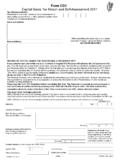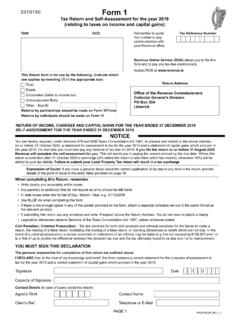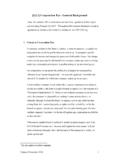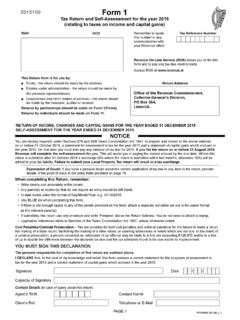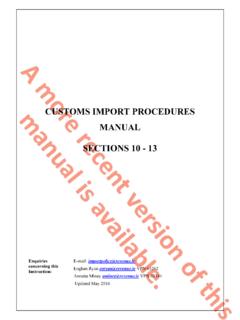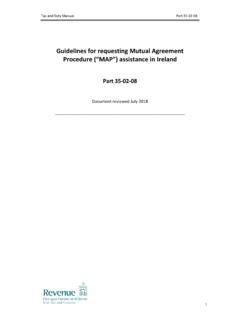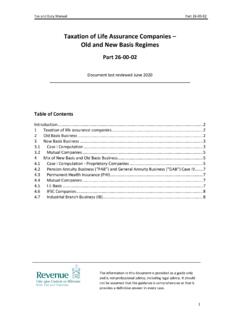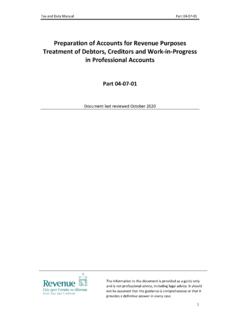Transcription of Employees' Motoring/Bicycle Expenses
1 Tax and Duty Manual part 05-02-05. Employees' Motoring/Bicycle Expenses part 05-02-05. This document was last updated May 2017. Tax and Duty Manual part 05-02-05. Contents 1. 2. Normal place of work ..3. 3. Business 4. Travel between Ireland and 5. Business Travel involving travel directly to or from home ..4. 6. Reimbursement of travel 7. Reimbursement by Flat-Rate kilometre 8. Reimbursement by reference to actual costs incurred ..5. 9. The Civil Service Rates for Motor Rates for Motorcycles ..7. Rates for 10. Records to be kept - Audit of 2. Tax and Duty Manual part 05-02-05. This manual explains the reimbursement of Motoring/Bicycle Expenses to employees (including directors). Tax and Duty Manual part 05-02-04 explains the reimbursement of subsistence Expenses to employees.
2 Revenue's Statement of Practice SP IT/2/2007 (PDF, 157KB) is a more detailed Revenue publication on the subject of the reimbursement of employees' Expenses of travel and subsistence. 1. Introduction In practice, two scenarios will generally arise: 1. the employer does not reimburse an employee in respect of the cost of the business journey, or 2. the employer reimburses an employee in respect of the cost of the business journey. Regarding 1 - an employee may claim a tax deduction in respect of travel Expenses necessarily incurred in performing the duties of his/her employment by submitting a claim to his/her Revenue office. Claims for these Expenses should be made after 31 December of the year in which they were incurred.
3 The claim form for car Expenses is available on or from our Forms & Leaflets service on 01 738 36 75 (or if calling from outside ROI. + 353 1 738 36 75). Regarding 2 - this manual sets out the circumstances under which such reimbursement may be made free of tax. 2. Normal place of work The normal place of work' is the place where the employee normally performs the duties of his or her employment. In most cases, this should not give rise to difficulty. The employer's business premises will be regarded as the normal place of work for an employee where: travel is an integral part of the job involving daily appointments with customers, or the duties of the employment are performed at the various premises of the employer's customers but substantive duties are also performed at the employer's business premises.
4 3. Tax and Duty Manual part 05-02-05. An employee's home would not be regarded as the normal place of work unless there is an objective requirement that the duties of the office or employment must be performed at home. It is not sufficient for an employee merely to carry out some of the duties at home. Usually, the employer will provide the facilities necessary for the work to be performed at the business premises. Even where an employee has to do some work at home or to keep some equipment at home, the place where he or she resides is a matter of personal choice and it would not be regarded as a place of work. 3. Business Journeys A business journey is one in which an employee travels from one place of work to another place of work in the performance of the duties of his or her employment but will generally involve a temporary absence from the normal place of work.
5 Journeys between an employee's home and place of work (and vice versa) are not business journeys and any reimbursement of motoring Expenses (including taxi fares) in respect of the cost of such journeys is taxable. 4. Travel between Ireland and Overseas Where an individual employed in Ireland is obliged to travel to a foreign location to temporarily perform the duties of his or her employment there, both the outward and the return journey home may be regarded as business journeys. 5. Business Travel involving travel directly to or from home Where an employee proceeds on a business journey directly from home to a temporary place of work (rather than commencing that business journey from his or her normal place of work) or returns home directly, the business kilometres should be calculated by reference to the lesser of: the distance between home and the temporary place of work, or the distance between the normal place of work and the temporary place of work.
6 6. Reimbursement of travel Expenses Where employees use their private cars, motorcycles or bicycles for business purposes, and the employees incur the total cost of such usage (for example, insurance, tax, running costs), then the reimbursement in respect of the cost of business use can be made free of tax by the employer by reference to either: flat-rate kilometre allowances (see 7 below), or 4. Tax and Duty Manual part 05-02-05. actual costs incurred (see 8 below). 7. Reimbursement by Flat-Rate kilometre allowances Kilometric allowances are calculated using a standard costs system to determine the Motoring/Bicycle Expenses which may be paid free of tax by employers in respect of travel Expenses incurred by employees on allowable business journeys.
7 The system applies where the car, motorcycle or bicycle is owned by the employee and all Motoring/Bicycle Expenses are met by the employee. There are two types of flat-rate allowance schemes which are acceptable for tax purposes. In both cases, a satisfactory recording and internal control system must be operated by the employer - see Records to be kept - Audit of Records. Scheme 1. Where the employee bears the cost of the relevant travelling Expenses , this scheme provides that the reimbursement of such Expenses in accordance with the prevailing schedule of Civil Service kilometric rates may be made free of tax. See The Civil Service rates. Scheme 2. Where the employee bears the cost of the relevant travelling Expenses , this scheme provides that the reimbursement of such Expenses in accordance with the schedule of rates, which do not exceed the prevailing schedule of Civil Service rates, may be made free of tax.
8 Either reimbursement scheme may be applied without specific Revenue approval. 8. Reimbursement by reference to actual costs incurred Where Motoring/Bicycle Expenses are reimbursed by employers to employees based on actual costs incurred, then the amount so reimbursed will generally not exceed the amount which would be payable in respect of the allowable business trips under the prevailing schedule of Civil Service rates. Where an employee's actual Motoring/Bicycle Expenses are reimbursed free of tax by an employer, the question of an income tax claim by the employee in respect of those Expenses does not arise. 9. The Civil Service rates The Civil Service kilometre rates for cars, motorcycles and bicycles for individuals who are obliged to use their car, motorcycle or bicycle in the performance of the duties of their employment, are as follows: 5.
9 Tax and Duty Manual part 05-02-05. Rates for Motor cars Motor cars effective from 1st April 2017. Distance Bands Engine Capacity Engine Capacity Engine Capacity up to 1200cc 1201cc to 1501cc and over 1500cc Band 1 0 1,500 km cent cent cent Band 2 1,501 5,500 km cent cent cent Band 3 5,501 25,000 km cent cent cent Band 4 25,001 km and over cent cent cent Motor cars effective from 5 March 2009 to 31 March 2017. Official Motor Engine Capacity: Engine Capacity: Engine Capacity: Travel in a Up to 1,200 cc 1,201 cc to 1,500 cc 1,501 cc and over calendar year Up to 6,437km cent cent cent 6,438km and over cent cent cent While business travel between 1 January 2017 and 31 March 2017 will not be affected by the introduction of these new bands and rates, business travel from 1.
10 January 2017 will, however, count towards aggregated mileage for the year. For example, an individual driving a car in the 1200-1500cc' engine size who had claimed 1,400km on 1st April 2017 would then move to the new Band 1 and receive cent per kilometre. Once they have driven a further 100km, they would then move to Band 2 and receive cent per kilometre. Reduced Motor Travel Rates per kilometre Engine Capacity Engine Capacity Engine Capacity up to 1200cc 1201cc to 1500cc 1501cc and over cent cent cent Reduced mileage rates are payable for journeys associated with an individual's job but not solely related to the performance of those duties. Examples include: attendance at confined promotion competitions attendance at approved courses of education attendance at courses or conferences return visits home at weekends during periods of temporary transfer.
